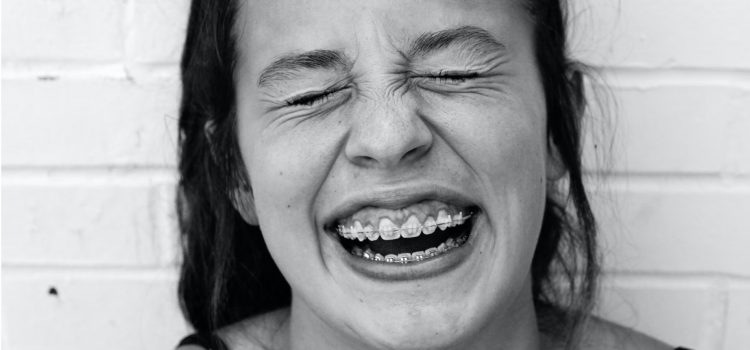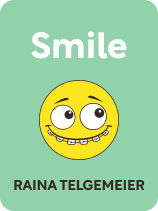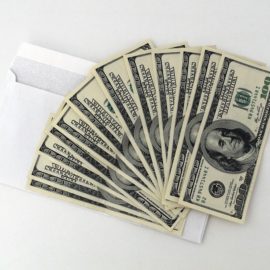

This article is an excerpt from the Shortform book guide to "Smile" by Raina Telgemeier. Shortform has the world's best summaries and analyses of books you should be reading.
Like this article? Sign up for a free trial here.
Looking for an overview of the Smile book by Raina Telgemeier? What is the book about? What are the book’s important events?
Comic artist Raina Telgemeier’s book Smile takes the reader through Telgemeier’s middle school years and dental struggles. The book sends an uplifting message to parents of adolescents, those who work with them, and those reflecting on their relationships with personal appearance.
Read on for a brief overview of the Smile book by Raina Telgemeier.
Smile Book Overview
Think back to middle school: the mounds of homework, the humiliation and excitement of crushes, and waking up to find that your body looks different than it did the day before. Imagine that on top of all of this, a face-first tumble onto the pavement has lodged your two front teeth higher into your mouth, and you’ve found out you’ll need years of dental work to correct your wonky teeth. This is all recounted in comic artist Raina Telgemeier’s book Smile, which explores her own middle school years in a graphic novel.
Through her exploration of adolescence, self-consciousness, romance, and the horrors of dental work, Telgemeier sends an uplifting message: that you can achieve confidence by focusing less on your appearance and more on your interests. While Telgemeier’s graphic novel is written primarily for middle school readers, the story she tells and the themes she explores are also relevant to those seeking to support adolescents, as well as adults hoping to reflect on their relationship with their appearance.
Telgemeier grew up in San Francisco, California, where Smile takes place, and she later moved to New York City to pursue a degree in illustration. Smile (published in 2010) is her first graphic novel, and it earned her the Eisner Award for Best Publication for Kids and Best Writer/Artist. She’s since published several other award-winning graphic novels for upper elementary and middle school readers.
Part 1: 6th Grade
At the beginning of the Smile book, Raina Telgemeier opens with a scene of herself forcing a grin: She’s at the dentist, and they’ve ordered her to smile wide so they can snap a photo of her teeth. After the dentist examines her mouth, he shares the news that she’ll soon need to get braces to correct her overbite—which Raina isn’t happy to hear.
| Supporting Youth Who Need Braces It’s common for children to have an overbite and get braces. Nearly 70% of U.S. children have some degree of an overbite (though not every child with an overbite receives treatment), and 50 to 70% of U.S. children get braces. It’s also common to dread getting braces, especially if you’re a teenager with concerns about your appearance. According to one expert, there are several ways to support a teenager who’s upset about needing braces. First, ensure they understand why they need to get braces in the first place. Describe what might happen if they don’t get braces—their teeth will grow more crooked, and they may need more intense intervention later in life. Next, help them identify their own reason why they need braces so they feel internally motivated to get them. For instance, perhaps they’re looking forward to having a straighter smile. Finally, highlight opportunities for choice, as adolescents naturally seek autonomy. For instance, they could pick what color bands to get. |
Little does Raina know, however, that braces aren’t the only dental work she’ll be needing in the near future. One day, she trips and lands face-first onto the pavement. To her horror, her tumble leaves her two front teeth missing. She finds one of her teeth on the pavement, but the other is nowhere to be seen.
An emergency visit to the dentist reveals why Raina couldn’t find her other tooth on the pavement: The force of her fall lodged it high into her gums. The dentist pulls this tooth back into its original position, reinserts her knocked-out tooth, and covers her top row of teeth in a cast to help it heal for several days.
(Shortform note: Experts estimate that around 25% of U.S. adolescents and adults receive care for dental trauma like Raina’s at some point. Dental trauma includes losing teeth, chipping teeth, and damage to the lips, the tongue, the gums, or the bone that holds your teeth.)
Raina is full of dread before her next visit to the dentist. After the dentist removes her cast, Raina receives more bad news: Her two front teeth aren’t where they should be. X-rays reveal that her fall damaged the bones above her top row of teeth. As a result, her two front teeth are lodged high into her gums, making it look like those teeth are half the length of her others. Raina is devastated when she learns that she’ll need to make many more trips to the dentist to correct this problem.
(Shortform note: According to one expert, offering your child a reward is an effective strategy for helping them manage their dread of getting braces. This strategy acknowledges that they’re going through a hard experience, and it replaces some of their dread with positive anticipation.)
Part 2: 7th Grade
The second part of the Smile book continues on with Raina Telgemeier in the first half of seventh grade. Raina’s teeth contribute to her feelings of self-consciousness. Her dentist shares the bad news that Raina’s braces are failing to pull her two front teeth down—therefore, she’ll need a different treatment that will require her to visit the dentist more frequently and get braces again. Raina spends weeks worrying about this new treatment and how “nerdy” she’ll look with braces. Her constant worrying makes it hard for her to pay attention at school.
Raina’s Friends Tease Her
After Raina begins her new dental treatment in the second half of the year, her friends tease her about her appearance. On one occasion, she expresses to her friends that her braces make her look like a nerd—and her friends reply that she is a nerd and has always looked like one. Raina storms away, upset, and her friends remark that she can’t take a joke.This teasing continues at Raina’s birthday sleepover. This time, her friends tease her by implying that she’s too unattractive to appeal to her new crush, Sean. They claim that she’ll appeal more to Sean if she improves her appearance. They give her a makeover, complete with garish makeup, revealing clothes, and ostentatious jewelry—then they hoot with laughter at her over-the-top look. When Raina becomes upset, her friends once again claim that she needs to lighten up.
Part 3: 8th Grade
The third part of the Smile book begins with Raina Telgemeier starting eight grade. Raina is focused on how she can win Sean’s attention, but her concerns about her appearance persist. Raina fantasizes about Sean kissing a more glammed-up version of herself—one who resembles a movie star with neatly-styled hair, clear skin, a great figure, and perfect teeth. When Raina snaps out of her fantasy, she reflects that due to her imperfect appearance, she likely won’t get to kiss Sean in the near future.
(Shortform note: When Raina fantasizes about Sean, she imagines an idealized version of herself rather than her current self. Some experts claim that imagining an idealized version of yourself boosts your ambition and success. For instance, self-help author Brian Tracy argues that the most successful people have a clear image of their ideal self and use it as a goal to strive toward. By contrast, others claim that it’s unhealthy to compare your idealized self to your current self because holding yourself to an impossibly high standard makes you feel inadequate. Raina’s fantasy about Sean supports this second theory about idealized selves: Her fantasy makes her feel worse about herself instead of motivated to work towards a goal.)
Part 4: 9th Grade
In the final part of Raina Telgemeier’s Smile book, she begins her first day of high school feeling more confident than usual: She likes how she looks in her new outfit, and her years of dental treatment have made her teeth look “almost-normal”—“almost” because she still has braces. Despite Raina feeling confident on her first day of high school, her confidence plummets when she joins her friends from eighth grade for lunch and overhears them reminiscing about summer plans that she hadn’t been invited to. This social exclusion soon escalates to hurtful teasing. Raina’s friends tease her when they see all of the items Raina has to carry in her backpack to maintain her oral health (such as mouthwash, rubber bands, and dental wax).
Raina Stands Up For Herself
This teasing soon escalates further when one of Raina’s friends has the “funny idea” to pull her skirt down while she’s waiting in the vending machine line during lunch. Raina storms off in a fit of tears. When her friends once again tell her to lighten up, Raina responds differently than she had in the past: She passionately scolds her friends for disrespecting her for so many years, and she declares that she’s done being their friend.Afterward, Raina proudly reflects that her choice to stand up for herself robbed her friends of the power they’d had over her for the past several years.
The final page of the Smile book highlights Raina Telgemeier’s newfound confidence. While she’s at a school dance with her friends, they snap a picture together in a photo booth. In the picture, Raina smiles—a wide, genuine smile.

———End of Preview———
Like what you just read? Read the rest of the world's best book summary and analysis of Raina Telgemeier's "Smile" at Shortform.
Here's what you'll find in our full Smile summary:
- An autobiographical novel of one middle schooler's traumatic experience
- The self-consciousness that comes with having braces as a child
- Tips for parents whose children are struggling with coming of age






